论文信息
论文标题:Rumor Detection on Twitter with Claim-Guided Hierarchical Graph Attention Networks论文作者:Erxue Min, Yu Rong, Yatao Bian, Tingyang Xu, Peilin Zhao, Junzhou Huang,Sophia Ananiadou论文来源:2021,EMNLP 论文地址:download 论文代码:download
Background
传播结构为谣言的真假提供了有用的线索,但是现有的谣言检测方法要么局限于用户相应关系,要么简化了对话结构。
本文说的 Claim 代表的是 Source post ,即源帖。
1 Introduction
如下为一个简单的 conversation thread 例子:
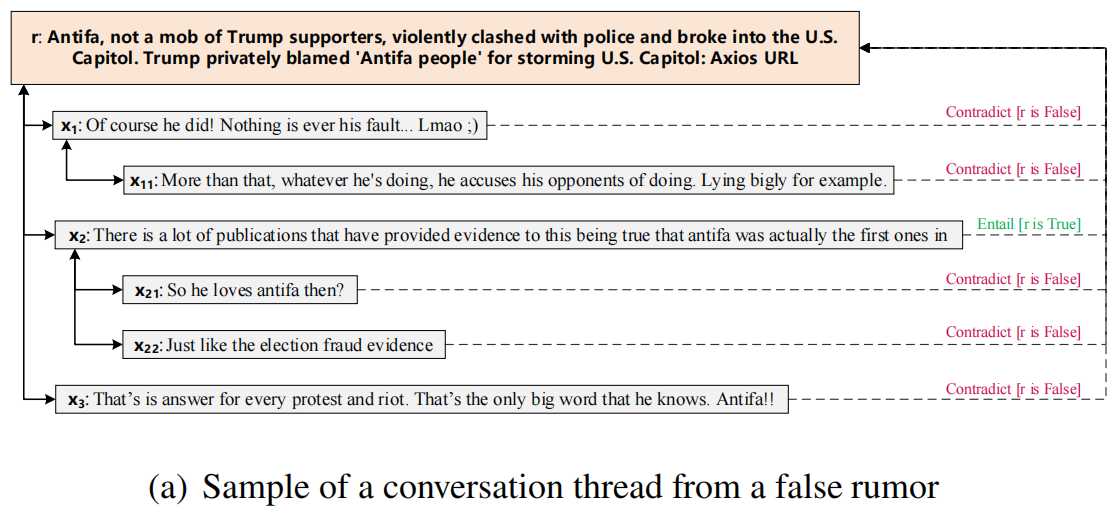
本文提出的点:考虑兄弟之间的关系,如下图虚线部分。
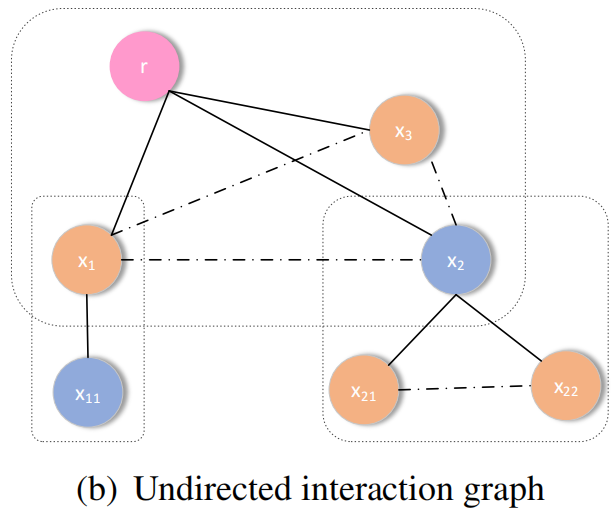
2 Claim-guided Hierarchical Graph Attention Networks
总体框架如下:
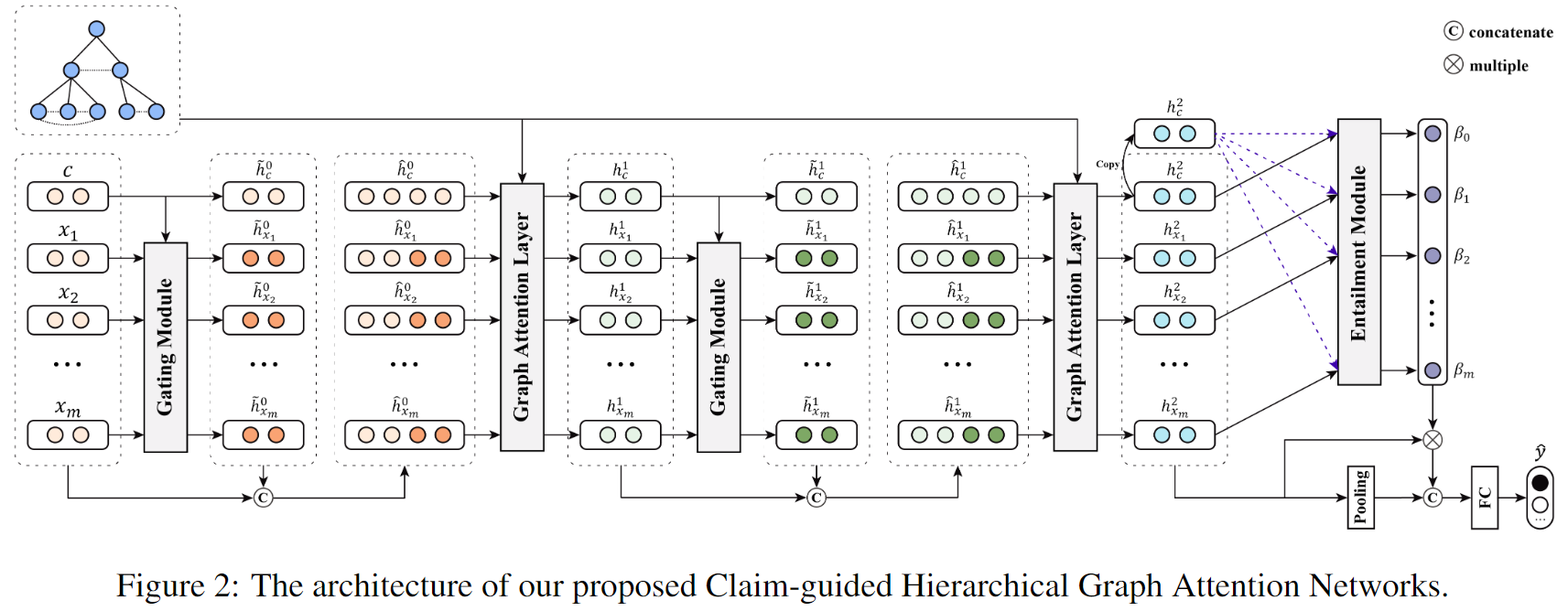
本文的模型包括两个注意力模块:
A Graph Attention to capture the importance of different neighboring tweets
A claim-guided hierarchical attention to enhance post content understanding
2.1 Claim-guided Hierarchical Attention
对于每个 tweet $x_i$ ,首先使用 Bi-LSTM 获得 Post 的特征矩阵 $X=\left[c, x_{1}, x_{2}, \cdots, x_{|\mathcal{V}|-1}\right]^{\top}$ ,其中 $c, x_{i} \in \mathbb{R}^{d}$。
为加强模型的主题一致性和语义推理:
Post-level Attention
为了防止主题偏离和丢失 claim 的信息,本文采用 gate module 决定它应该接受 claim 多少信息,以更好地指导相关职位的重要性分配。claim-aware representation 具体如下:
$\begin{array}{l}g_{c \rightarrow x_{i}}^{(l)} &=&\operatorname{sigmoid}\left(W_{g}^{(l)} h_{x_{i}}^{(l)}+U_{g}^{(l)} h_{c}^{(l)}\right) \\\tilde{h}_{x_{i}}^{(l)} &=&g_{c \rightarrow x_{i}}^{(l)} \odot h_{x_{i}}^{(l)}+\left(1-g_{c \rightarrow x_{i}}^{(l)}\right) \odot h_{c}^{(l)}\end{array}$
其中,$g_{c \rightarrow x_{i}}^{(l)}$ 是一个 gate vector,$W_{g}^{(l)}$ 和 $U_{g}^{(l)}$ 是可学习参数。
然后,将 claim-aware representation 与 original representation 拼接起来,作为 $\text{Eq.1}$ 的输入去计算注意力权重: $\begin{array}{l}\hat{h}_{x_{i}}^{(l)}=\left[\tilde{h}_{x_{i}}^{(l)} \| h_{x_{i}}^{(l)}\right] \\\hat{\alpha}_{i, j}^{(l)}=\operatorname{Atten}\left(\hat{h}_{x_{i}}^{(l)}, \hat{h}_{x_{j}}^{(l)}\right)\end{array}$
2.2 Graph Attention Networks
为了编码结构信息,本文使用 GAT encoder: 输入:$H^{(l)}=\left[h_{c}^{(l)}, h_{x_{1}}^{(l)}, h_{x_{2}}^{(l)}, \ldots, h_{x_{|\mathcal{V}|-1}}^{(l)}\right]^{\top}$ 过程: ${\large \begin{aligned}\alpha_{i, j}^{(l)} &=\operatorname{Atten}\left(h_{x_{i}}^{(l)}, h_{x_{j}}^{(l)}\right) \\&=\frac{\exp \left(\phi\left(a^{\top}\left[W^{(l)} h_{x_{i}}^{(l)} \| W^{(l)} h_{x_{j}}^{(l)}\right]\right)\right)}{\sum_{j \in \mathcal{N}_{i}} \exp \left(\phi\left(a^{\top}\left[W^{(l)} h_{x_{i}}^{(l)} \| W^{(l)} h_{x_{j}}^{(l)}\right]\right)\right)}\end{aligned}} $
$h_{x_{i}}^{(l+1)}=\operatorname{Re} L U\left(\sum\limits_{j \in \mathcal{N}_{i}} \alpha_{i, j}^{(l)} W^{(l)} h_{x_{j}}^{(l)}\right)$
考虑多头注意力:
$h_{x_{i}}^{(l+1)}=\|_{k=1}^{K} \operatorname{ReLU}\left(\sum\limits _{j \in \mathcal{N}_{i}} \alpha_{i, j}^{(l, k)} W_{k}^{(l)} h_{x_{j}}^{(l)}\right)$
替换输出层的表示向量:
${\large h_{x_{i}}^{(L)}=\operatorname{Re} L U\left(\frac{1}{K} \sum\limits _{k=1}^{K} \sum\limits_{j \in \mathcal{N}_{i}} \alpha_{i, j}^{\left(l^{\prime}, k\right)} W_{k}^{\left(l^{\prime}\right)} h_{x_{j}}^{\left(l^{\prime}\right)}\right)} $
输出:图表示
$\bar{s}=\text { mean-pooling }\left(H^{(L)}\right)$
Event-level Attention
出发点:获得图表示的时候采用的 平均池化并不是一定有意义的,可能存在某些节点对于图分类来说更准确。
受到 Natural Language Inference (NLI) 的影响,本文考虑对 GAT 最后一层的 $h_{c}^{(L)}$ 和 $\left.h_{x_{i}}^{(L)}: 1\right)$ 做如下处理 :
1)concatenation $\left[h_{c}^{(L)} \| h_{x_{i}}^{(L)}\right]$
2)element-wise product $h_{\text {prod }}^{(L)}=h_{c}^{(L)} \odot h_{x_{i}}^{(L)}$
3)absolute element-wise difference $h_{\text {diff }}^{(L)}=\left|h_{c}^{(L)}-h_{x_{i}}^{(L)}\right|$
接着获得一个联合表示:
$h_{x_{i}}^{c}=\tanh \left(F C\left(\left[h_{c}^{(L)}\left\|h_{x_{i}}^{(L)}\right\| h_{\text {prod }}^{(L)} \| h_{\text {diff }}^{(L)}\right]\right)\right)$
通过使用该联合表示计算 Event-level Attention :
${\large \begin{array}{l}b_{i} &=&\tanh \left(F C\left(h_{x_{i}}^{c}\right)\right) \\\beta_{i} &=&\frac{\exp \left(b_{i}\right)}{\sum_{i} \exp \left(b_{i}\right)} \\\hat{s} &&=\sum_{i} \beta_{i} h_{x_{i}}^{(L)}\end{array}} $
最后将其 $\hat{S}$ 与 GAT 最后一层的平均池化图表示 $\bar{s}$ 拼接作为最终图表示,并进行分类:
$\hat{y}=\operatorname{softmax}(F C([\hat{s} \| \bar{s}]))$
3 Experiments
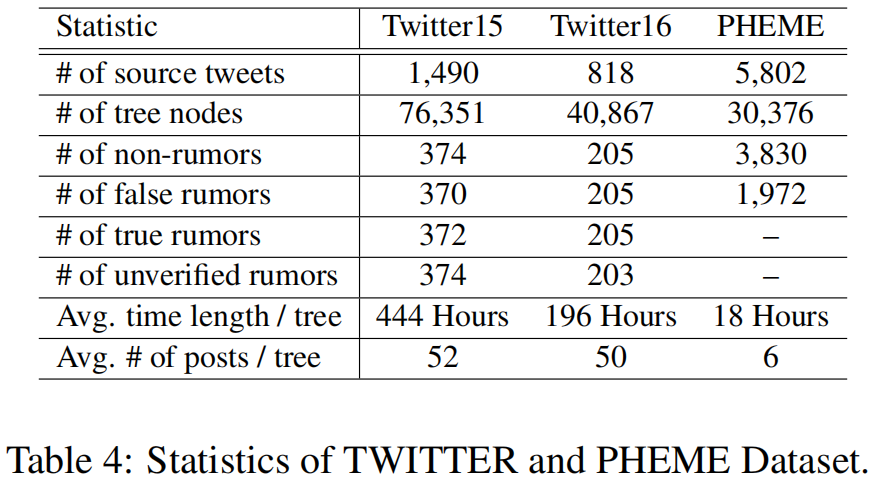
3.2 Rumor Classifification Performance
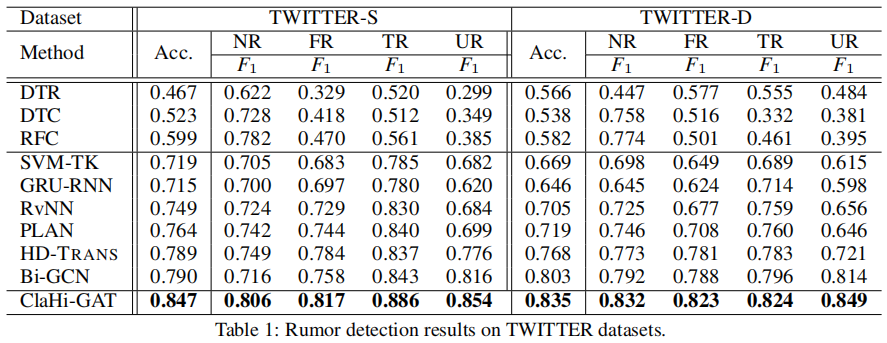
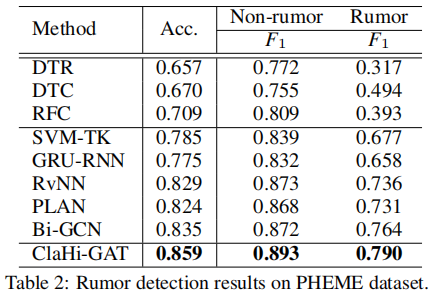
3.3 Ablation Study
1) ClaHi-GAT/DT: Instead of the undirected interaction graph, we use the directed trees as the model input.
2) GAT+EA+SC: We simply concatenate the features of the claim with the node features at each GAT layer, to replace the claim-aware representation.
3) w/o EA: We discard the event-level (inference-based) attention as presented.
4) w/o PA: We neglect the post-level (claim-aware) attention by leaving out the gating module introduced.
5) GAT: The backbone model.
6) GCN: The vanilla graph convolutional networks with no attention.
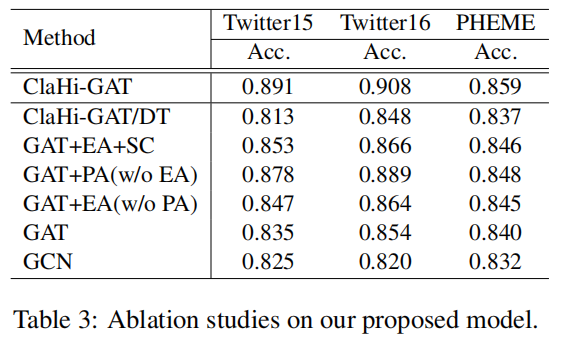
3.4 Evaluation of Undirected Interaction Graphs
ClaHi-GAT/DT Utilize the directional tree applied in past influential works as the modeling way instead of our proposed undirected interaction graph.
ClaHi-GAT/DTS Based on the directional tree structure similar to ClaHi-GAT/DT but the explicit interactions between sibling nodes are taken into account.
ClaHi-GAT/UD The modeling way is our undirected interaction topology but without considering the explicit correlations between sibling nodes that reply to the same target.
ClaHi-GAT In this paper, we propose to model the conversation thread as an undirected interaction graph for our claim-guided hierarchical graph attention networks.
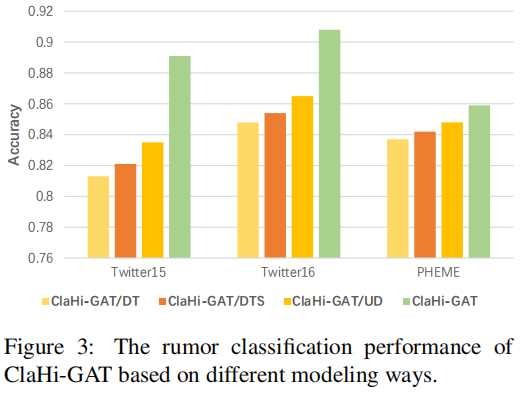
3.5 Early Rumor Detection
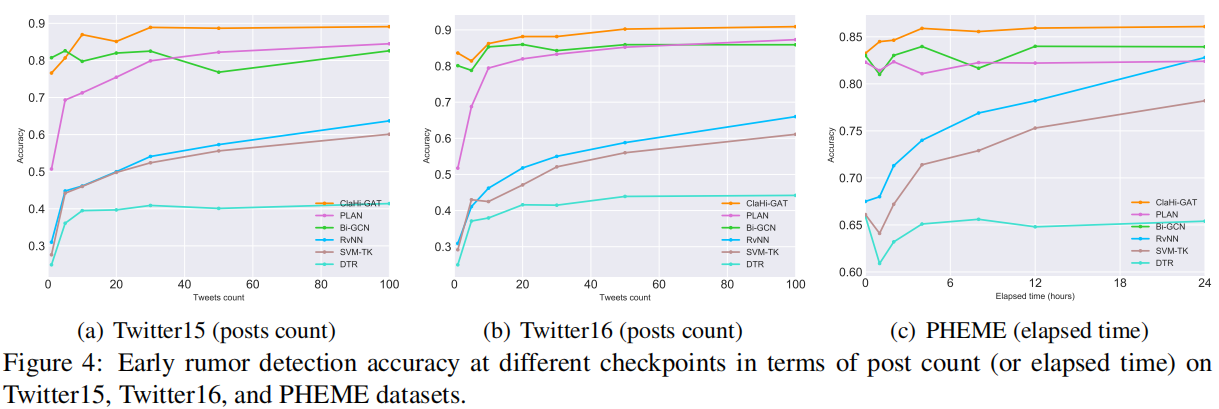
关键点:随着 claim 的传播,或多或少会产生更多的语义信息和噪声,所以使用 claim 的信息至关重要。
举例说明:false claim 的注意力分数得分图如下:
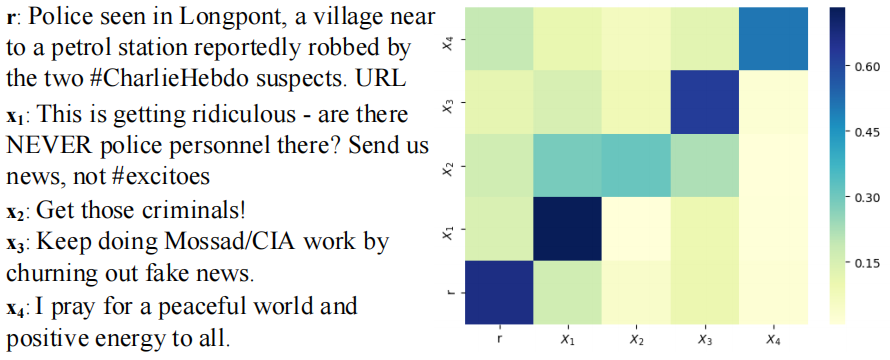
言下之意:错误的 post $x_2$ 会被赋予较小的权重,这就是为什么该模型早期谣言检测比较稳定的原因。
标签: # 谣言检测

留言评论